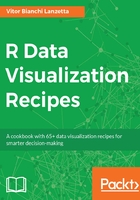
Installing and loading graphics packages
Before starting, there are some habits you may want to cultivate in order to keep improving your R skills. First of all, whenever you program there may be some challenges to face. Usually those are tackled either by out-thinking the problem or by doing some research. You might want to remember what the problem was about and the solution, be that for times you face it again later or even for studying hours, keep a record of problems and solutions.
Speaking for me, making a library-like folder and gathering some commented examples on problems and resolutions was, and still is, of great help. Naming files properly and taking good use of comments (# are used to assign comments with R) makes the revision much easier.
R Markdown documents are pretty useful if want to keep a track of your own development and optionally publish for others to see. Publishing the learning process is a good way to self-promote. Also, keep in mind that R is a programming language and often those can correctly pull a problem out in more than one way, be open-minded to seek different solutions.
First things first, in order to make good use of a package, you need to install the package and know how to call a package's function.
If your R Session is running for a long time, there is a good chance that a bunch of packages are already loaded. Before installing or updating a package it's a good practice to restart R so that the installation won't mess with related loaded packages.